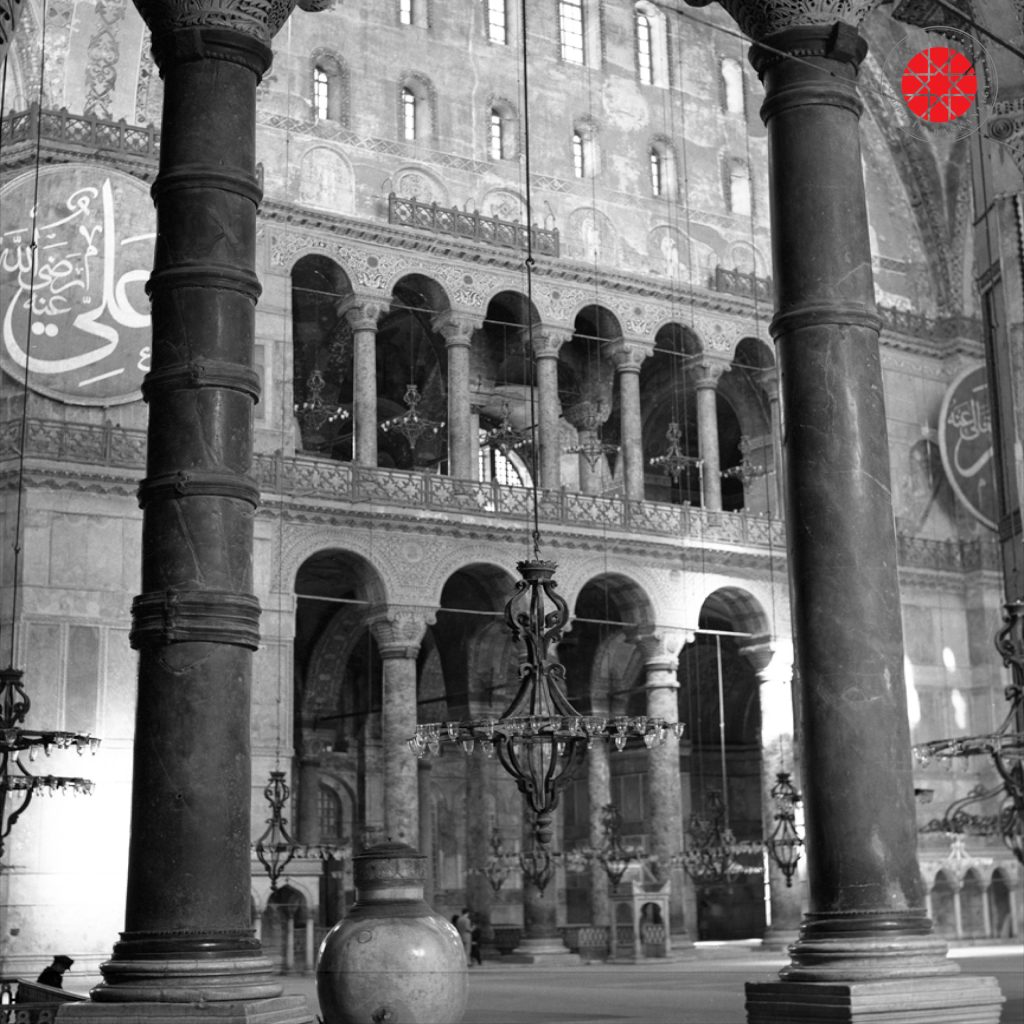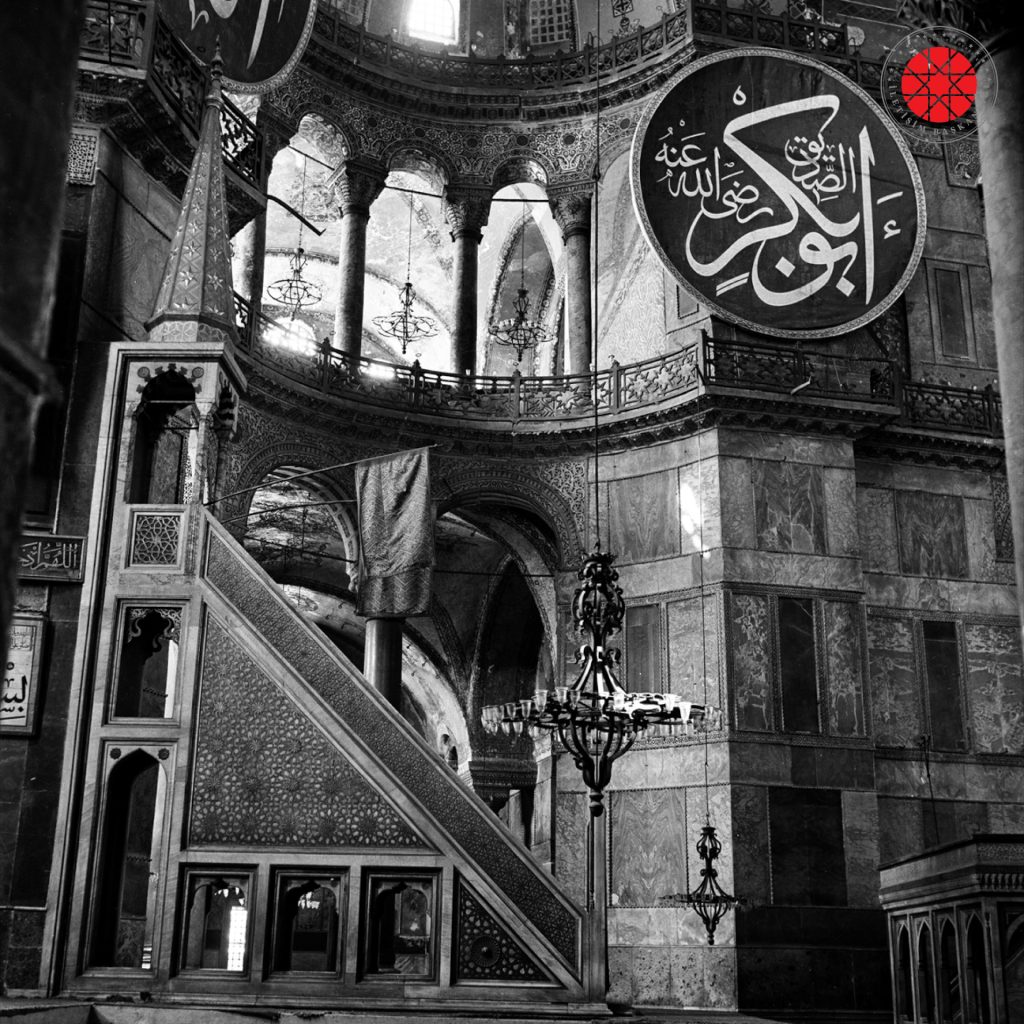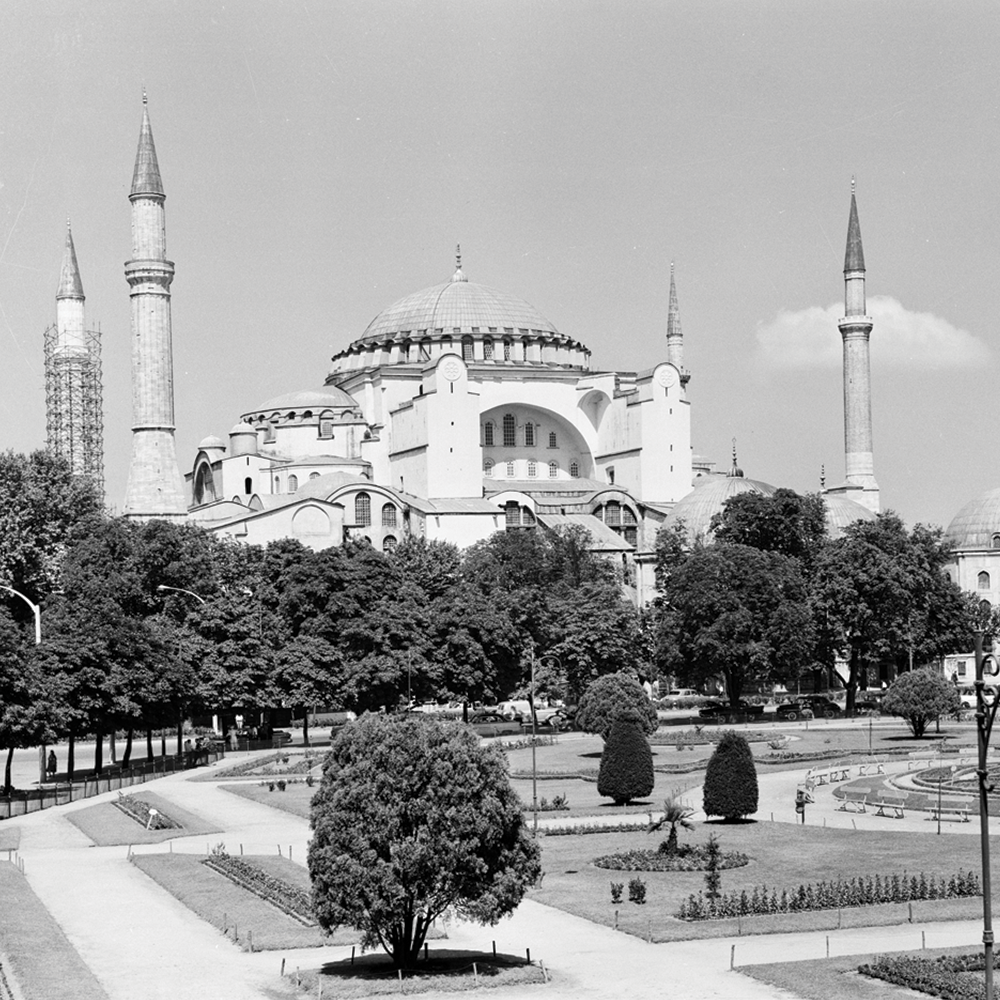 Hagia Sophia is a monument built on the same site three times. Today’s Hagia Sophia is known as the “Third Hagia Sophia”. The first construction of Hagia Sophia began during the reign of Constantine I, who adopted Christianity as the official religion of the Roman Empire. Constructed as a basilica with a wooden roof on the first of the seven hills of Istanbul and known as the ‘Great Church’ at the time, this building was opened in 360 during the reign of Constantine II. As a result of a fire that broke out in 404 during a rebellion, this building was largely destroyed and no remains of it have survived to the present day.
Hagia Sophia is a monument built on the same site three times. Today’s Hagia Sophia is known as the “Third Hagia Sophia”. The first construction of Hagia Sophia began during the reign of Constantine I, who adopted Christianity as the official religion of the Roman Empire. Constructed as a basilica with a wooden roof on the first of the seven hills of Istanbul and known as the ‘Great Church’ at the time, this building was opened in 360 during the reign of Constantine II. As a result of a fire that broke out in 404 during a rebellion, this building was largely destroyed and no remains of it have survived to the present day.
The second Hagia Sophia was built by Emperor Theodosius II on the site of the first one and opened for worship in 415. This building, which was also built in the form of a basilica with a wooden roof, was burned and destroyed by the rebels during the Nika Revolt against Emperor Justinian in 532.
Immediately after the revolt, Emperor Justinian decided to build magnificent Hagia Sophia which was much bigger than the first two. The third Hagia Sophia was built by the Byzantine Emperor Justinian I between 532-537.
Used as the Imperial Church of Eastern Rome, Hagia Sophia was destroyed many times by rebellions, wars and natural disasters throughout history. Hagia Sophia suffered one of its greatest destructions in 1204 when the city was overrun during the 4th Crusade. The Crusaders plundered Hagia Sophia as well as the whole city. During the Latin occupation of Istanbul from 1204 to 1261, Hagia Sophia was converted into a cathedral under the Roman Catholic Church.
The Hagia Sophia, which had suffered serious damages, was tried to be kept standing with repairs after the Eastern Roman rule was restored in Istanbul. However, the repairs were not sufficient and in 1346 the eastern archivolt of the Hagia Sophia and part of the dome collapsed.
In fact, Hagia Sophia experienced its darkest age from the Latin invasion until the conquest of Constantinople. Hagia Sophia, which was destroyed twice and rebuilt for the third time, destroyed by wars and rebellions for centuries and whose certain parts collapsed due to neglect and architectural mistakes, continued its existence under the constant danger of collapse until the conquest of Istanbul by Sultan Mehmed the Conqueror. In addition, due to the Catholic-Orthodox sectarian strife, the sociological and symbolic meaning of the shrine suffered significantly.
The Ottomans took great care of the Hagia Sophia Mosque, which they accepted and valued as a sign of the conquest, since the time of Mehmed the Conqueror, and made maintenance and repair activities permanent and restored the mosque to a much stronger structure than before. Especially the additions and arrangements made by Sinan the Architect on Hagia Sophia have played a major role in the survival of this heritage of humanity until today.
As a matter of fact, it is reported in historical records that Fatih Sultan Mehmed Khan, who went to Hagia Sophia immediately after the conquest, was saddened by the condition of the mosque and recited the following verses:
“Perdedâri mîkoned ber kasr-i Kayser ankebut Bûm novbet mîzened der tarem-i Efrâsiyâb”
(“The spider weaves curtains in Caesar’s palace;The owl calls the watch in the halls of Afrasiyab.”)
 Sultan Mehmed the Conqueror, who dedicated the Hagia Sophia Mosque as his own charity and secured its maintenance and repair costs by granting it many funds, first started educational activities by having a madrasah built next to the mosque. The first minaret of Hagia Sophia was also built from wood during the reign of Fatih Sultan Mehmed Khan. This minaret, which existed for many years, was removed during the major renovation in 1574. The second minaret of the Hagia Sophia Mosque was built of brick during the reign of Sultan Bayezid II.
Sultan Mehmed the Conqueror, who dedicated the Hagia Sophia Mosque as his own charity and secured its maintenance and repair costs by granting it many funds, first started educational activities by having a madrasah built next to the mosque. The first minaret of Hagia Sophia was also built from wood during the reign of Fatih Sultan Mehmed Khan. This minaret, which existed for many years, was removed during the major renovation in 1574. The second minaret of the Hagia Sophia Mosque was built of brick during the reign of Sultan Bayezid II.
One of the Ottoman Sultans who showed the greatest interest in Hagia Sophia was Sultan Selim II. As the building showed signs of aging, Selim II Khan assigned Sinan the Architect for the maintenance and repair of Hagia Sophia. Hagia Sophia, whose domes and walls collapsed many times during the Eastern Roman period, has never collapsed again after the renovations of Sinan the Architect, despite many major earthquakes in Istanbul. The construction of sultans’ mausoleums around Hagia Sophia began with the first mausoleum built by Sinan the Architect for Sultan Selim II Khan in the treasury section of the Hagia Sophia Complex.
Every Sultan starting from Sultan Mehmet the Conqueror has endeavored to further improve Hagia Sophia, and over time, Hagia Sophia was transformed into a complete complex with structures such as the mihrab, minbar, pulpit, minarets, sultan’s lodge, fountain, madrasa, library and soup kitchen, etc. In addition, great importance was given to the interior decorations of the Hagia Sophia Mosque during the Ottoman period. Hagia Sophia was adorned with the finest examples of Turkish arts, such as calligraphy and tile work, and new aesthetic values were brought to the place of worship. Thus, Hagia Sophia has not only been transformed into a mosque, but also this common heritage of humanity has been preserved and revived.
Hagia Sophia, which was converted into a mosque with the conquest and served as a mosque for 481 years, was closed to the public with the start of restoration works in the 1930s. Then, by a decision of the Council of Ministers dated November 24, 1934, it was converted into a museum. The Council of State annulled the Council of Ministers’ decision on July 10, 2020. Immediately afterwards, Hagia Sophia has been reopened for worship with the Presidential Decree No. 2729 issued with the signature of President Recep Tayyip Erdoğan.



